University Report: Inclusive Practice and Culturally Responsive Care
VerifiedAdded on 2020/04/07
|9
|3027
|500
Report
AI Summary
This report, prepared for NURS11162, Inclusive Practice for Nursing, explores the challenges faced by marginalized groups in Australia. It examines the effects of social stigma on the health and well-being of wheelchair users, the visually impaired, and homeless people. The report further analyzes social inclusion and human rights issues, highlighting government policies designed to promote the integration of these groups into society. The discussion covers the impact of marginalization on access to services, employment, and overall quality of life, as well as the policies and legal frameworks in place to address these issues. The report concludes with a personal perspective on the topic and the importance of culturally responsive care.
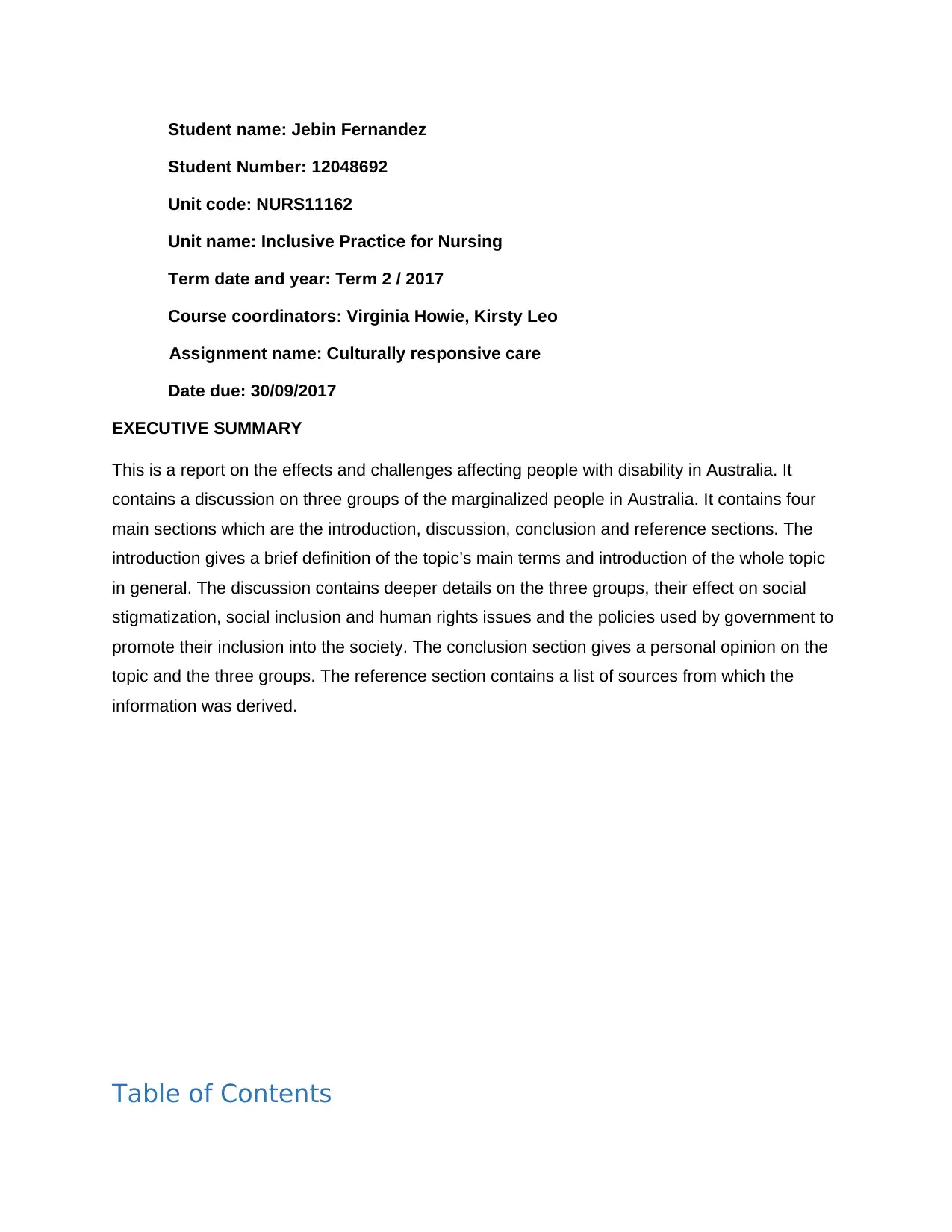
Student name: Jebin Fernandez
Student Number: 12048692
Unit code: NURS11162
Unit name: Inclusive Practice for Nursing
Term date and year: Term 2 / 2017
Course coordinators: Virginia Howie, Kirsty Leo
Assignment name: Culturally responsive care
Date due: 30/09/2017
EXECUTIVE SUMMARY
This is a report on the effects and challenges affecting people with disability in Australia. It
contains a discussion on three groups of the marginalized people in Australia. It contains four
main sections which are the introduction, discussion, conclusion and reference sections. The
introduction gives a brief definition of the topic’s main terms and introduction of the whole topic
in general. The discussion contains deeper details on the three groups, their effect on social
stigmatization, social inclusion and human rights issues and the policies used by government to
promote their inclusion into the society. The conclusion section gives a personal opinion on the
topic and the three groups. The reference section contains a list of sources from which the
information was derived.
Table of Contents
Student Number: 12048692
Unit code: NURS11162
Unit name: Inclusive Practice for Nursing
Term date and year: Term 2 / 2017
Course coordinators: Virginia Howie, Kirsty Leo
Assignment name: Culturally responsive care
Date due: 30/09/2017
EXECUTIVE SUMMARY
This is a report on the effects and challenges affecting people with disability in Australia. It
contains a discussion on three groups of the marginalized people in Australia. It contains four
main sections which are the introduction, discussion, conclusion and reference sections. The
introduction gives a brief definition of the topic’s main terms and introduction of the whole topic
in general. The discussion contains deeper details on the three groups, their effect on social
stigmatization, social inclusion and human rights issues and the policies used by government to
promote their inclusion into the society. The conclusion section gives a personal opinion on the
topic and the three groups. The reference section contains a list of sources from which the
information was derived.
Table of Contents
Paraphrase This Document
Need a fresh take? Get an instant paraphrase of this document with our AI Paraphraser
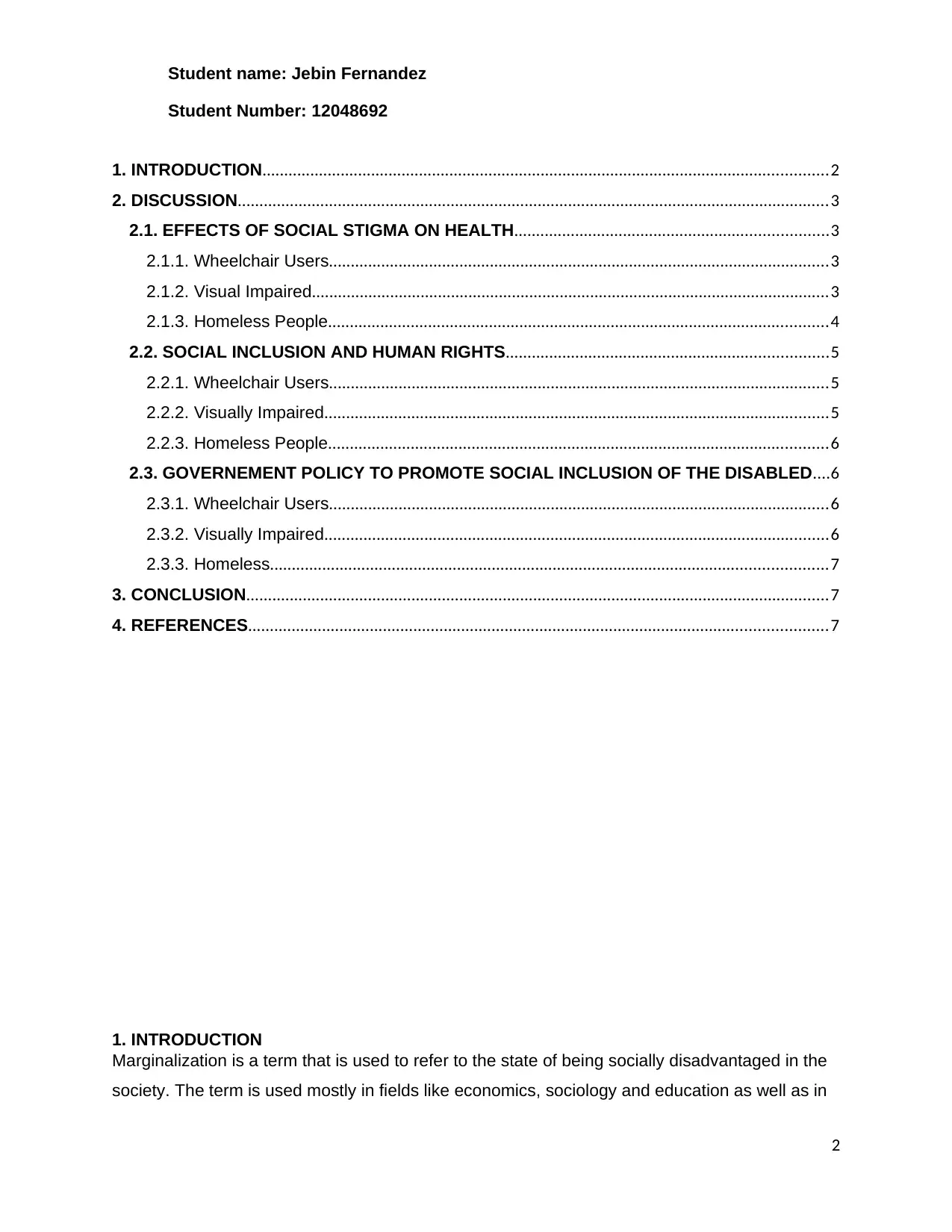
Student name: Jebin Fernandez
Student Number: 12048692
1. INTRODUCTION..................................................................................................................................2
2. DISCUSSION........................................................................................................................................3
2.1. EFFECTS OF SOCIAL STIGMA ON HEALTH........................................................................3
2.1.1. Wheelchair Users...................................................................................................................3
2.1.2. Visual Impaired.......................................................................................................................3
2.1.3. Homeless People...................................................................................................................4
2.2. SOCIAL INCLUSION AND HUMAN RIGHTS..........................................................................5
2.2.1. Wheelchair Users...................................................................................................................5
2.2.2. Visually Impaired....................................................................................................................5
2.2.3. Homeless People...................................................................................................................6
2.3. GOVERNEMENT POLICY TO PROMOTE SOCIAL INCLUSION OF THE DISABLED....6
2.3.1. Wheelchair Users...................................................................................................................6
2.3.2. Visually Impaired....................................................................................................................6
2.3.3. Homeless................................................................................................................................7
3. CONCLUSION......................................................................................................................................7
4. REFERENCES.....................................................................................................................................7
1. INTRODUCTION
Marginalization is a term that is used to refer to the state of being socially disadvantaged in the
society. The term is used mostly in fields like economics, sociology and education as well as in
2
Student Number: 12048692
1. INTRODUCTION..................................................................................................................................2
2. DISCUSSION........................................................................................................................................3
2.1. EFFECTS OF SOCIAL STIGMA ON HEALTH........................................................................3
2.1.1. Wheelchair Users...................................................................................................................3
2.1.2. Visual Impaired.......................................................................................................................3
2.1.3. Homeless People...................................................................................................................4
2.2. SOCIAL INCLUSION AND HUMAN RIGHTS..........................................................................5
2.2.1. Wheelchair Users...................................................................................................................5
2.2.2. Visually Impaired....................................................................................................................5
2.2.3. Homeless People...................................................................................................................6
2.3. GOVERNEMENT POLICY TO PROMOTE SOCIAL INCLUSION OF THE DISABLED....6
2.3.1. Wheelchair Users...................................................................................................................6
2.3.2. Visually Impaired....................................................................................................................6
2.3.3. Homeless................................................................................................................................7
3. CONCLUSION......................................................................................................................................7
4. REFERENCES.....................................................................................................................................7
1. INTRODUCTION
Marginalization is a term that is used to refer to the state of being socially disadvantaged in the
society. The term is used mostly in fields like economics, sociology and education as well as in
2
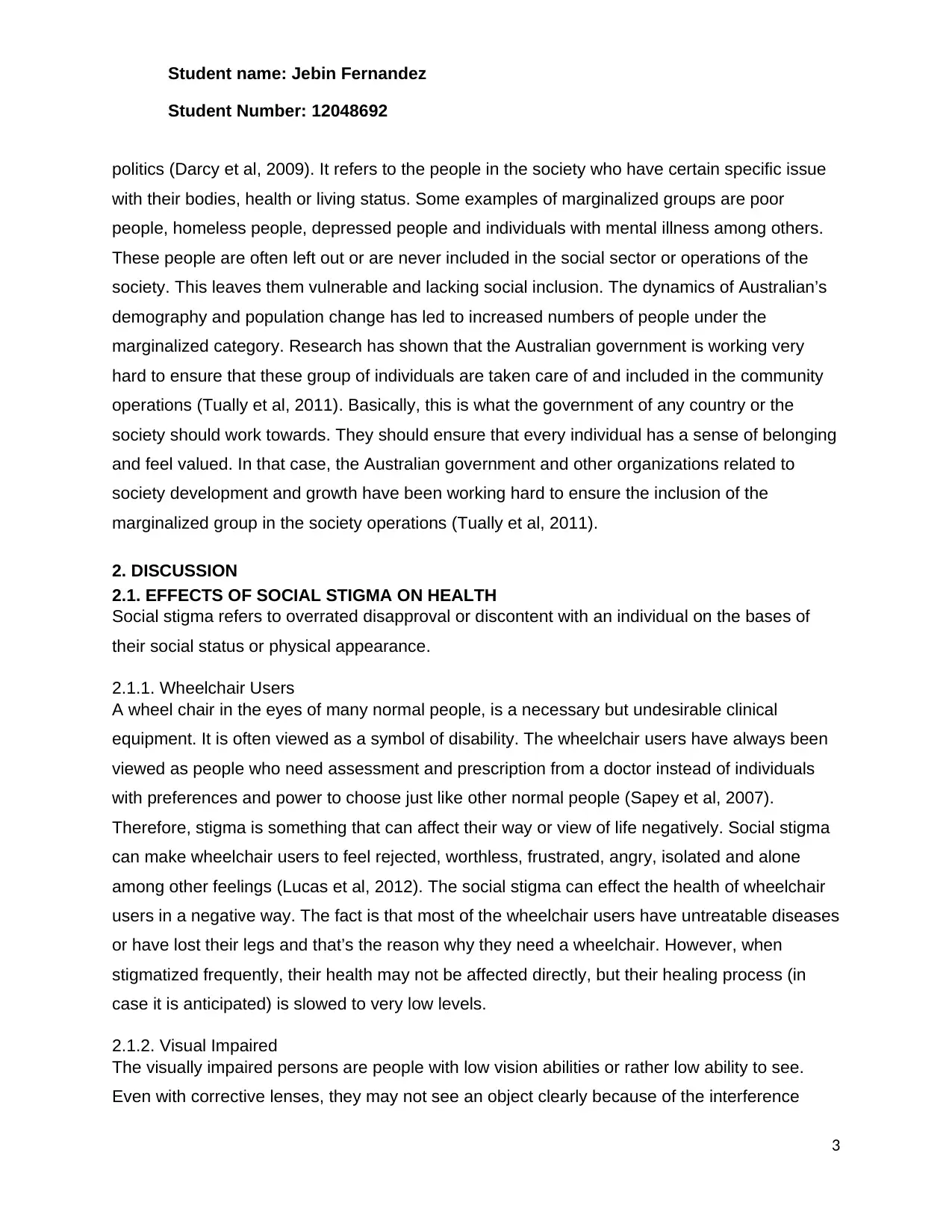
Student name: Jebin Fernandez
Student Number: 12048692
politics (Darcy et al, 2009). It refers to the people in the society who have certain specific issue
with their bodies, health or living status. Some examples of marginalized groups are poor
people, homeless people, depressed people and individuals with mental illness among others.
These people are often left out or are never included in the social sector or operations of the
society. This leaves them vulnerable and lacking social inclusion. The dynamics of Australian’s
demography and population change has led to increased numbers of people under the
marginalized category. Research has shown that the Australian government is working very
hard to ensure that these group of individuals are taken care of and included in the community
operations (Tually et al, 2011). Basically, this is what the government of any country or the
society should work towards. They should ensure that every individual has a sense of belonging
and feel valued. In that case, the Australian government and other organizations related to
society development and growth have been working hard to ensure the inclusion of the
marginalized group in the society operations (Tually et al, 2011).
2. DISCUSSION
2.1. EFFECTS OF SOCIAL STIGMA ON HEALTH
Social stigma refers to overrated disapproval or discontent with an individual on the bases of
their social status or physical appearance.
2.1.1. Wheelchair Users
A wheel chair in the eyes of many normal people, is a necessary but undesirable clinical
equipment. It is often viewed as a symbol of disability. The wheelchair users have always been
viewed as people who need assessment and prescription from a doctor instead of individuals
with preferences and power to choose just like other normal people (Sapey et al, 2007).
Therefore, stigma is something that can affect their way or view of life negatively. Social stigma
can make wheelchair users to feel rejected, worthless, frustrated, angry, isolated and alone
among other feelings (Lucas et al, 2012). The social stigma can effect the health of wheelchair
users in a negative way. The fact is that most of the wheelchair users have untreatable diseases
or have lost their legs and that’s the reason why they need a wheelchair. However, when
stigmatized frequently, their health may not be affected directly, but their healing process (in
case it is anticipated) is slowed to very low levels.
2.1.2. Visual Impaired
The visually impaired persons are people with low vision abilities or rather low ability to see.
Even with corrective lenses, they may not see an object clearly because of the interference
3
Student Number: 12048692
politics (Darcy et al, 2009). It refers to the people in the society who have certain specific issue
with their bodies, health or living status. Some examples of marginalized groups are poor
people, homeless people, depressed people and individuals with mental illness among others.
These people are often left out or are never included in the social sector or operations of the
society. This leaves them vulnerable and lacking social inclusion. The dynamics of Australian’s
demography and population change has led to increased numbers of people under the
marginalized category. Research has shown that the Australian government is working very
hard to ensure that these group of individuals are taken care of and included in the community
operations (Tually et al, 2011). Basically, this is what the government of any country or the
society should work towards. They should ensure that every individual has a sense of belonging
and feel valued. In that case, the Australian government and other organizations related to
society development and growth have been working hard to ensure the inclusion of the
marginalized group in the society operations (Tually et al, 2011).
2. DISCUSSION
2.1. EFFECTS OF SOCIAL STIGMA ON HEALTH
Social stigma refers to overrated disapproval or discontent with an individual on the bases of
their social status or physical appearance.
2.1.1. Wheelchair Users
A wheel chair in the eyes of many normal people, is a necessary but undesirable clinical
equipment. It is often viewed as a symbol of disability. The wheelchair users have always been
viewed as people who need assessment and prescription from a doctor instead of individuals
with preferences and power to choose just like other normal people (Sapey et al, 2007).
Therefore, stigma is something that can affect their way or view of life negatively. Social stigma
can make wheelchair users to feel rejected, worthless, frustrated, angry, isolated and alone
among other feelings (Lucas et al, 2012). The social stigma can effect the health of wheelchair
users in a negative way. The fact is that most of the wheelchair users have untreatable diseases
or have lost their legs and that’s the reason why they need a wheelchair. However, when
stigmatized frequently, their health may not be affected directly, but their healing process (in
case it is anticipated) is slowed to very low levels.
2.1.2. Visual Impaired
The visually impaired persons are people with low vision abilities or rather low ability to see.
Even with corrective lenses, they may not see an object clearly because of the interference
3
⊘ This is a preview!⊘
Do you want full access?
Subscribe today to unlock all pages.

Trusted by 1+ million students worldwide
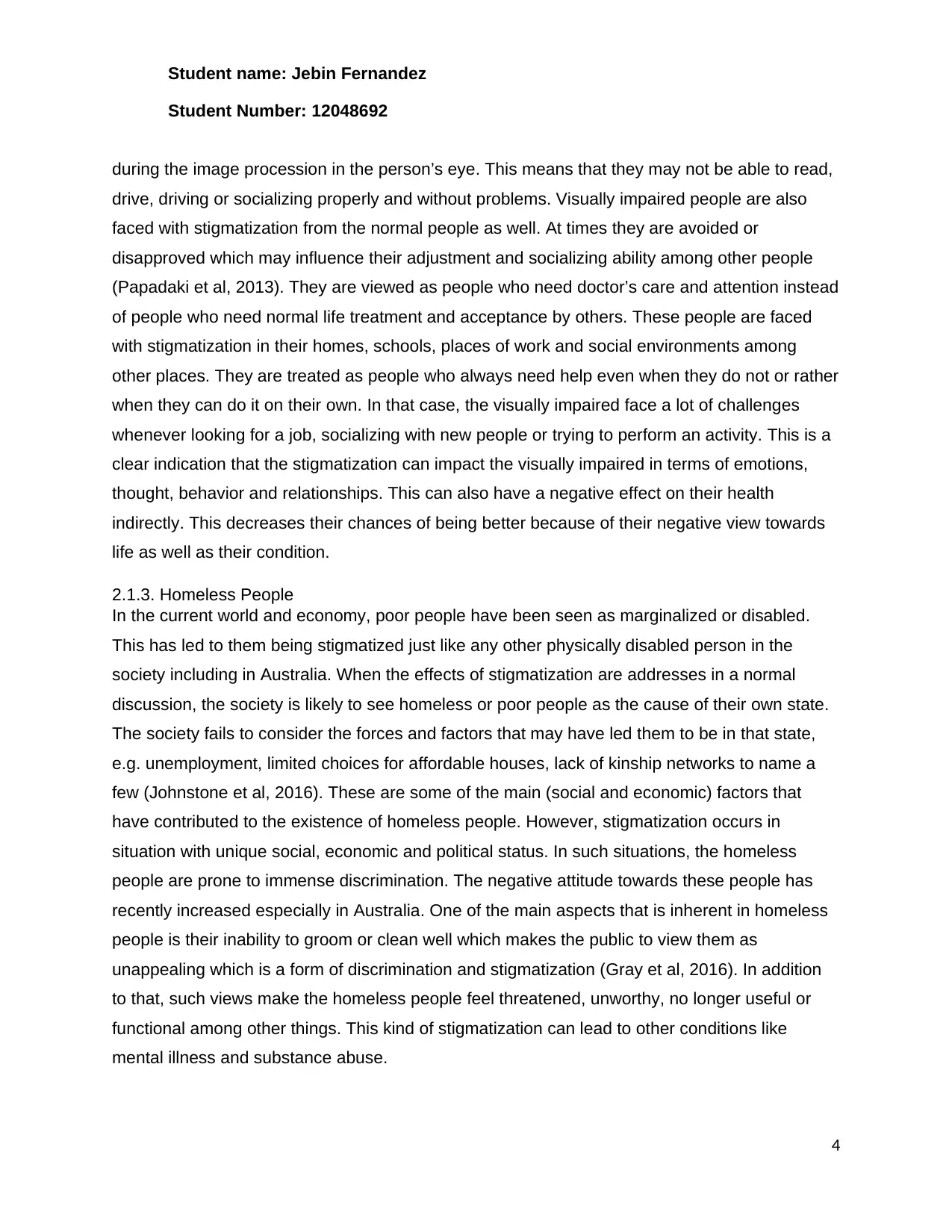
Student name: Jebin Fernandez
Student Number: 12048692
during the image procession in the person’s eye. This means that they may not be able to read,
drive, driving or socializing properly and without problems. Visually impaired people are also
faced with stigmatization from the normal people as well. At times they are avoided or
disapproved which may influence their adjustment and socializing ability among other people
(Papadaki et al, 2013). They are viewed as people who need doctor’s care and attention instead
of people who need normal life treatment and acceptance by others. These people are faced
with stigmatization in their homes, schools, places of work and social environments among
other places. They are treated as people who always need help even when they do not or rather
when they can do it on their own. In that case, the visually impaired face a lot of challenges
whenever looking for a job, socializing with new people or trying to perform an activity. This is a
clear indication that the stigmatization can impact the visually impaired in terms of emotions,
thought, behavior and relationships. This can also have a negative effect on their health
indirectly. This decreases their chances of being better because of their negative view towards
life as well as their condition.
2.1.3. Homeless People
In the current world and economy, poor people have been seen as marginalized or disabled.
This has led to them being stigmatized just like any other physically disabled person in the
society including in Australia. When the effects of stigmatization are addresses in a normal
discussion, the society is likely to see homeless or poor people as the cause of their own state.
The society fails to consider the forces and factors that may have led them to be in that state,
e.g. unemployment, limited choices for affordable houses, lack of kinship networks to name a
few (Johnstone et al, 2016). These are some of the main (social and economic) factors that
have contributed to the existence of homeless people. However, stigmatization occurs in
situation with unique social, economic and political status. In such situations, the homeless
people are prone to immense discrimination. The negative attitude towards these people has
recently increased especially in Australia. One of the main aspects that is inherent in homeless
people is their inability to groom or clean well which makes the public to view them as
unappealing which is a form of discrimination and stigmatization (Gray et al, 2016). In addition
to that, such views make the homeless people feel threatened, unworthy, no longer useful or
functional among other things. This kind of stigmatization can lead to other conditions like
mental illness and substance abuse.
4
Student Number: 12048692
during the image procession in the person’s eye. This means that they may not be able to read,
drive, driving or socializing properly and without problems. Visually impaired people are also
faced with stigmatization from the normal people as well. At times they are avoided or
disapproved which may influence their adjustment and socializing ability among other people
(Papadaki et al, 2013). They are viewed as people who need doctor’s care and attention instead
of people who need normal life treatment and acceptance by others. These people are faced
with stigmatization in their homes, schools, places of work and social environments among
other places. They are treated as people who always need help even when they do not or rather
when they can do it on their own. In that case, the visually impaired face a lot of challenges
whenever looking for a job, socializing with new people or trying to perform an activity. This is a
clear indication that the stigmatization can impact the visually impaired in terms of emotions,
thought, behavior and relationships. This can also have a negative effect on their health
indirectly. This decreases their chances of being better because of their negative view towards
life as well as their condition.
2.1.3. Homeless People
In the current world and economy, poor people have been seen as marginalized or disabled.
This has led to them being stigmatized just like any other physically disabled person in the
society including in Australia. When the effects of stigmatization are addresses in a normal
discussion, the society is likely to see homeless or poor people as the cause of their own state.
The society fails to consider the forces and factors that may have led them to be in that state,
e.g. unemployment, limited choices for affordable houses, lack of kinship networks to name a
few (Johnstone et al, 2016). These are some of the main (social and economic) factors that
have contributed to the existence of homeless people. However, stigmatization occurs in
situation with unique social, economic and political status. In such situations, the homeless
people are prone to immense discrimination. The negative attitude towards these people has
recently increased especially in Australia. One of the main aspects that is inherent in homeless
people is their inability to groom or clean well which makes the public to view them as
unappealing which is a form of discrimination and stigmatization (Gray et al, 2016). In addition
to that, such views make the homeless people feel threatened, unworthy, no longer useful or
functional among other things. This kind of stigmatization can lead to other conditions like
mental illness and substance abuse.
4
Paraphrase This Document
Need a fresh take? Get an instant paraphrase of this document with our AI Paraphraser
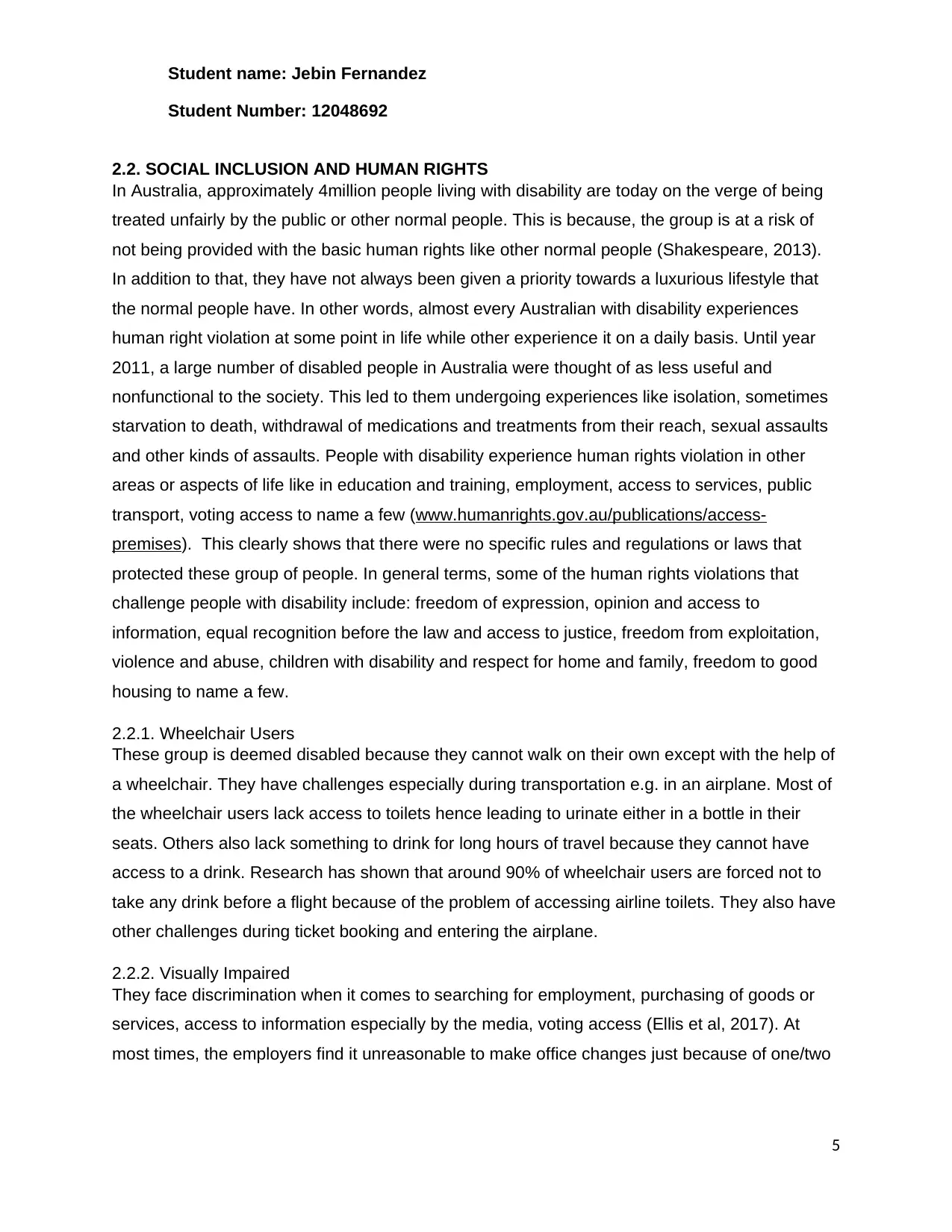
Student name: Jebin Fernandez
Student Number: 12048692
2.2. SOCIAL INCLUSION AND HUMAN RIGHTS
In Australia, approximately 4million people living with disability are today on the verge of being
treated unfairly by the public or other normal people. This is because, the group is at a risk of
not being provided with the basic human rights like other normal people (Shakespeare, 2013).
In addition to that, they have not always been given a priority towards a luxurious lifestyle that
the normal people have. In other words, almost every Australian with disability experiences
human right violation at some point in life while other experience it on a daily basis. Until year
2011, a large number of disabled people in Australia were thought of as less useful and
nonfunctional to the society. This led to them undergoing experiences like isolation, sometimes
starvation to death, withdrawal of medications and treatments from their reach, sexual assaults
and other kinds of assaults. People with disability experience human rights violation in other
areas or aspects of life like in education and training, employment, access to services, public
transport, voting access to name a few (www.humanrights.gov.au/publications/access-
premises). This clearly shows that there were no specific rules and regulations or laws that
protected these group of people. In general terms, some of the human rights violations that
challenge people with disability include: freedom of expression, opinion and access to
information, equal recognition before the law and access to justice, freedom from exploitation,
violence and abuse, children with disability and respect for home and family, freedom to good
housing to name a few.
2.2.1. Wheelchair Users
These group is deemed disabled because they cannot walk on their own except with the help of
a wheelchair. They have challenges especially during transportation e.g. in an airplane. Most of
the wheelchair users lack access to toilets hence leading to urinate either in a bottle in their
seats. Others also lack something to drink for long hours of travel because they cannot have
access to a drink. Research has shown that around 90% of wheelchair users are forced not to
take any drink before a flight because of the problem of accessing airline toilets. They also have
other challenges during ticket booking and entering the airplane.
2.2.2. Visually Impaired
They face discrimination when it comes to searching for employment, purchasing of goods or
services, access to information especially by the media, voting access (Ellis et al, 2017). At
most times, the employers find it unreasonable to make office changes just because of one/two
5
Student Number: 12048692
2.2. SOCIAL INCLUSION AND HUMAN RIGHTS
In Australia, approximately 4million people living with disability are today on the verge of being
treated unfairly by the public or other normal people. This is because, the group is at a risk of
not being provided with the basic human rights like other normal people (Shakespeare, 2013).
In addition to that, they have not always been given a priority towards a luxurious lifestyle that
the normal people have. In other words, almost every Australian with disability experiences
human right violation at some point in life while other experience it on a daily basis. Until year
2011, a large number of disabled people in Australia were thought of as less useful and
nonfunctional to the society. This led to them undergoing experiences like isolation, sometimes
starvation to death, withdrawal of medications and treatments from their reach, sexual assaults
and other kinds of assaults. People with disability experience human rights violation in other
areas or aspects of life like in education and training, employment, access to services, public
transport, voting access to name a few (www.humanrights.gov.au/publications/access-
premises). This clearly shows that there were no specific rules and regulations or laws that
protected these group of people. In general terms, some of the human rights violations that
challenge people with disability include: freedom of expression, opinion and access to
information, equal recognition before the law and access to justice, freedom from exploitation,
violence and abuse, children with disability and respect for home and family, freedom to good
housing to name a few.
2.2.1. Wheelchair Users
These group is deemed disabled because they cannot walk on their own except with the help of
a wheelchair. They have challenges especially during transportation e.g. in an airplane. Most of
the wheelchair users lack access to toilets hence leading to urinate either in a bottle in their
seats. Others also lack something to drink for long hours of travel because they cannot have
access to a drink. Research has shown that around 90% of wheelchair users are forced not to
take any drink before a flight because of the problem of accessing airline toilets. They also have
other challenges during ticket booking and entering the airplane.
2.2.2. Visually Impaired
They face discrimination when it comes to searching for employment, purchasing of goods or
services, access to information especially by the media, voting access (Ellis et al, 2017). At
most times, the employers find it unreasonable to make office changes just because of one/two
5
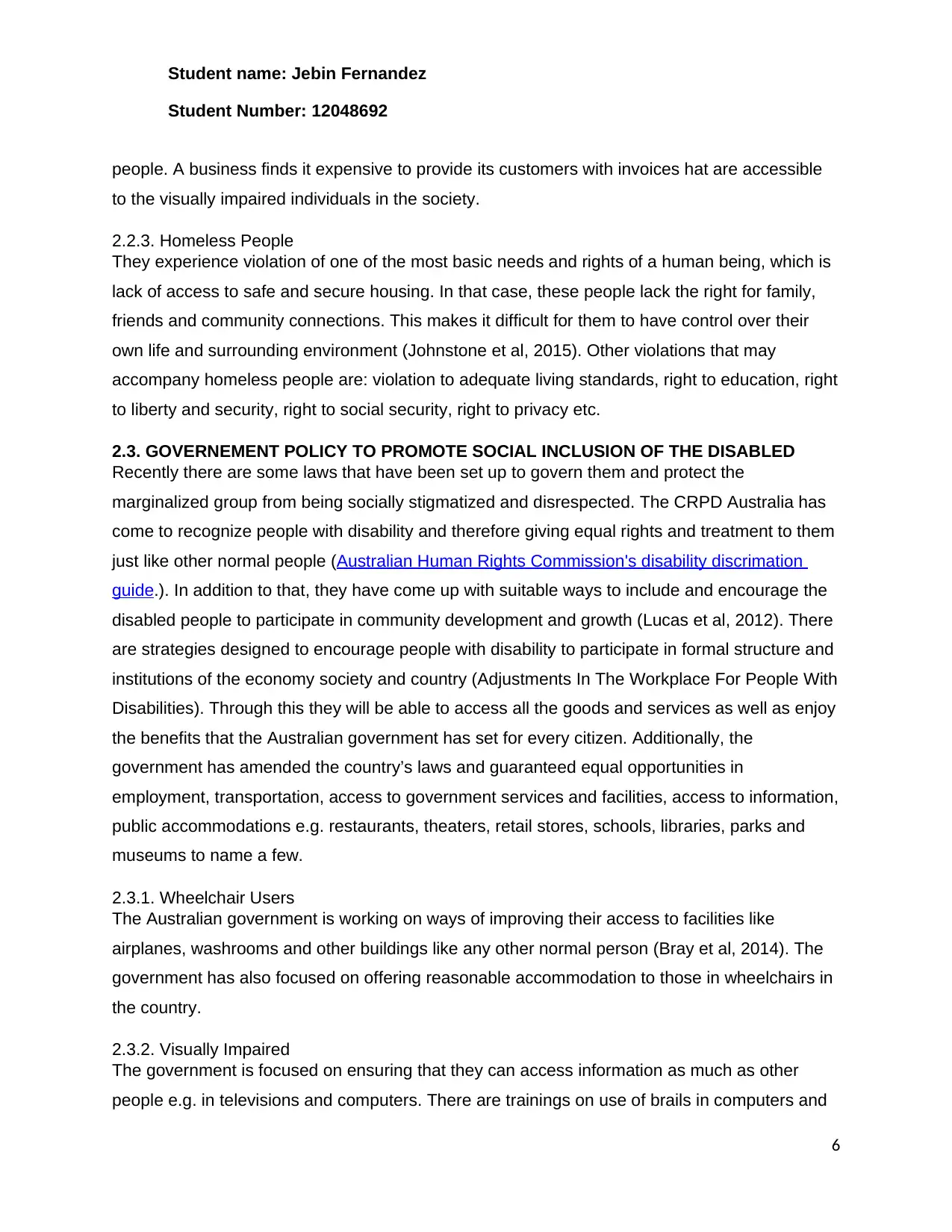
Student name: Jebin Fernandez
Student Number: 12048692
people. A business finds it expensive to provide its customers with invoices hat are accessible
to the visually impaired individuals in the society.
2.2.3. Homeless People
They experience violation of one of the most basic needs and rights of a human being, which is
lack of access to safe and secure housing. In that case, these people lack the right for family,
friends and community connections. This makes it difficult for them to have control over their
own life and surrounding environment (Johnstone et al, 2015). Other violations that may
accompany homeless people are: violation to adequate living standards, right to education, right
to liberty and security, right to social security, right to privacy etc.
2.3. GOVERNEMENT POLICY TO PROMOTE SOCIAL INCLUSION OF THE DISABLED
Recently there are some laws that have been set up to govern them and protect the
marginalized group from being socially stigmatized and disrespected. The CRPD Australia has
come to recognize people with disability and therefore giving equal rights and treatment to them
just like other normal people (Australian Human Rights Commission's disability discrimation
guide.). In addition to that, they have come up with suitable ways to include and encourage the
disabled people to participate in community development and growth (Lucas et al, 2012). There
are strategies designed to encourage people with disability to participate in formal structure and
institutions of the economy society and country (Adjustments In The Workplace For People With
Disabilities). Through this they will be able to access all the goods and services as well as enjoy
the benefits that the Australian government has set for every citizen. Additionally, the
government has amended the country’s laws and guaranteed equal opportunities in
employment, transportation, access to government services and facilities, access to information,
public accommodations e.g. restaurants, theaters, retail stores, schools, libraries, parks and
museums to name a few.
2.3.1. Wheelchair Users
The Australian government is working on ways of improving their access to facilities like
airplanes, washrooms and other buildings like any other normal person (Bray et al, 2014). The
government has also focused on offering reasonable accommodation to those in wheelchairs in
the country.
2.3.2. Visually Impaired
The government is focused on ensuring that they can access information as much as other
people e.g. in televisions and computers. There are trainings on use of brails in computers and
6
Student Number: 12048692
people. A business finds it expensive to provide its customers with invoices hat are accessible
to the visually impaired individuals in the society.
2.2.3. Homeless People
They experience violation of one of the most basic needs and rights of a human being, which is
lack of access to safe and secure housing. In that case, these people lack the right for family,
friends and community connections. This makes it difficult for them to have control over their
own life and surrounding environment (Johnstone et al, 2015). Other violations that may
accompany homeless people are: violation to adequate living standards, right to education, right
to liberty and security, right to social security, right to privacy etc.
2.3. GOVERNEMENT POLICY TO PROMOTE SOCIAL INCLUSION OF THE DISABLED
Recently there are some laws that have been set up to govern them and protect the
marginalized group from being socially stigmatized and disrespected. The CRPD Australia has
come to recognize people with disability and therefore giving equal rights and treatment to them
just like other normal people (Australian Human Rights Commission's disability discrimation
guide.). In addition to that, they have come up with suitable ways to include and encourage the
disabled people to participate in community development and growth (Lucas et al, 2012). There
are strategies designed to encourage people with disability to participate in formal structure and
institutions of the economy society and country (Adjustments In The Workplace For People With
Disabilities). Through this they will be able to access all the goods and services as well as enjoy
the benefits that the Australian government has set for every citizen. Additionally, the
government has amended the country’s laws and guaranteed equal opportunities in
employment, transportation, access to government services and facilities, access to information,
public accommodations e.g. restaurants, theaters, retail stores, schools, libraries, parks and
museums to name a few.
2.3.1. Wheelchair Users
The Australian government is working on ways of improving their access to facilities like
airplanes, washrooms and other buildings like any other normal person (Bray et al, 2014). The
government has also focused on offering reasonable accommodation to those in wheelchairs in
the country.
2.3.2. Visually Impaired
The government is focused on ensuring that they can access information as much as other
people e.g. in televisions and computers. There are trainings on use of brails in computers and
6
⊘ This is a preview!⊘
Do you want full access?
Subscribe today to unlock all pages.

Trusted by 1+ million students worldwide
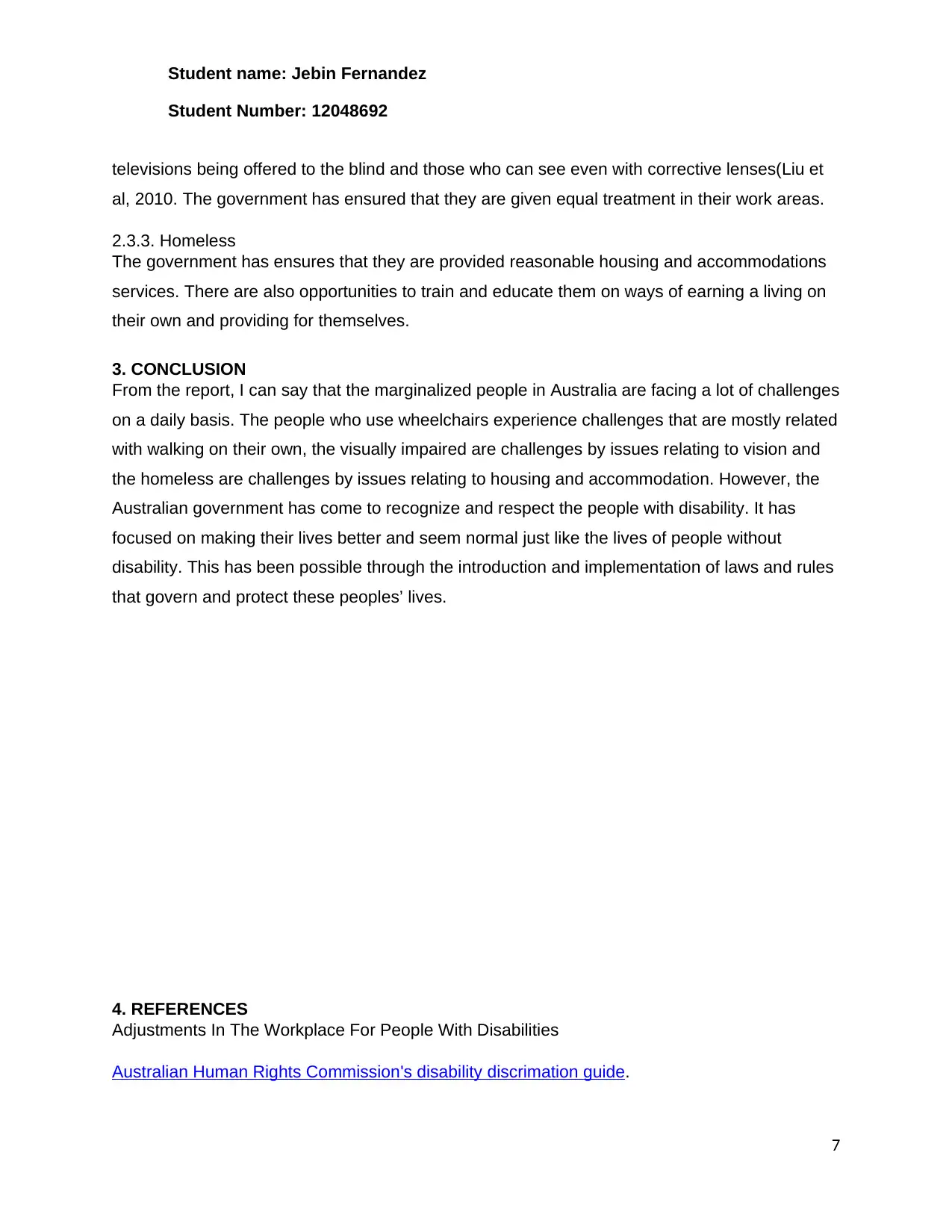
Student name: Jebin Fernandez
Student Number: 12048692
televisions being offered to the blind and those who can see even with corrective lenses(Liu et
al, 2010. The government has ensured that they are given equal treatment in their work areas.
2.3.3. Homeless
The government has ensures that they are provided reasonable housing and accommodations
services. There are also opportunities to train and educate them on ways of earning a living on
their own and providing for themselves.
3. CONCLUSION
From the report, I can say that the marginalized people in Australia are facing a lot of challenges
on a daily basis. The people who use wheelchairs experience challenges that are mostly related
with walking on their own, the visually impaired are challenges by issues relating to vision and
the homeless are challenges by issues relating to housing and accommodation. However, the
Australian government has come to recognize and respect the people with disability. It has
focused on making their lives better and seem normal just like the lives of people without
disability. This has been possible through the introduction and implementation of laws and rules
that govern and protect these peoples’ lives.
4. REFERENCES
Adjustments In The Workplace For People With Disabilities
Australian Human Rights Commission's disability discrimation guide.
7
Student Number: 12048692
televisions being offered to the blind and those who can see even with corrective lenses(Liu et
al, 2010. The government has ensured that they are given equal treatment in their work areas.
2.3.3. Homeless
The government has ensures that they are provided reasonable housing and accommodations
services. There are also opportunities to train and educate them on ways of earning a living on
their own and providing for themselves.
3. CONCLUSION
From the report, I can say that the marginalized people in Australia are facing a lot of challenges
on a daily basis. The people who use wheelchairs experience challenges that are mostly related
with walking on their own, the visually impaired are challenges by issues relating to vision and
the homeless are challenges by issues relating to housing and accommodation. However, the
Australian government has come to recognize and respect the people with disability. It has
focused on making their lives better and seem normal just like the lives of people without
disability. This has been possible through the introduction and implementation of laws and rules
that govern and protect these peoples’ lives.
4. REFERENCES
Adjustments In The Workplace For People With Disabilities
Australian Human Rights Commission's disability discrimation guide.
7
Paraphrase This Document
Need a fresh take? Get an instant paraphrase of this document with our AI Paraphraser
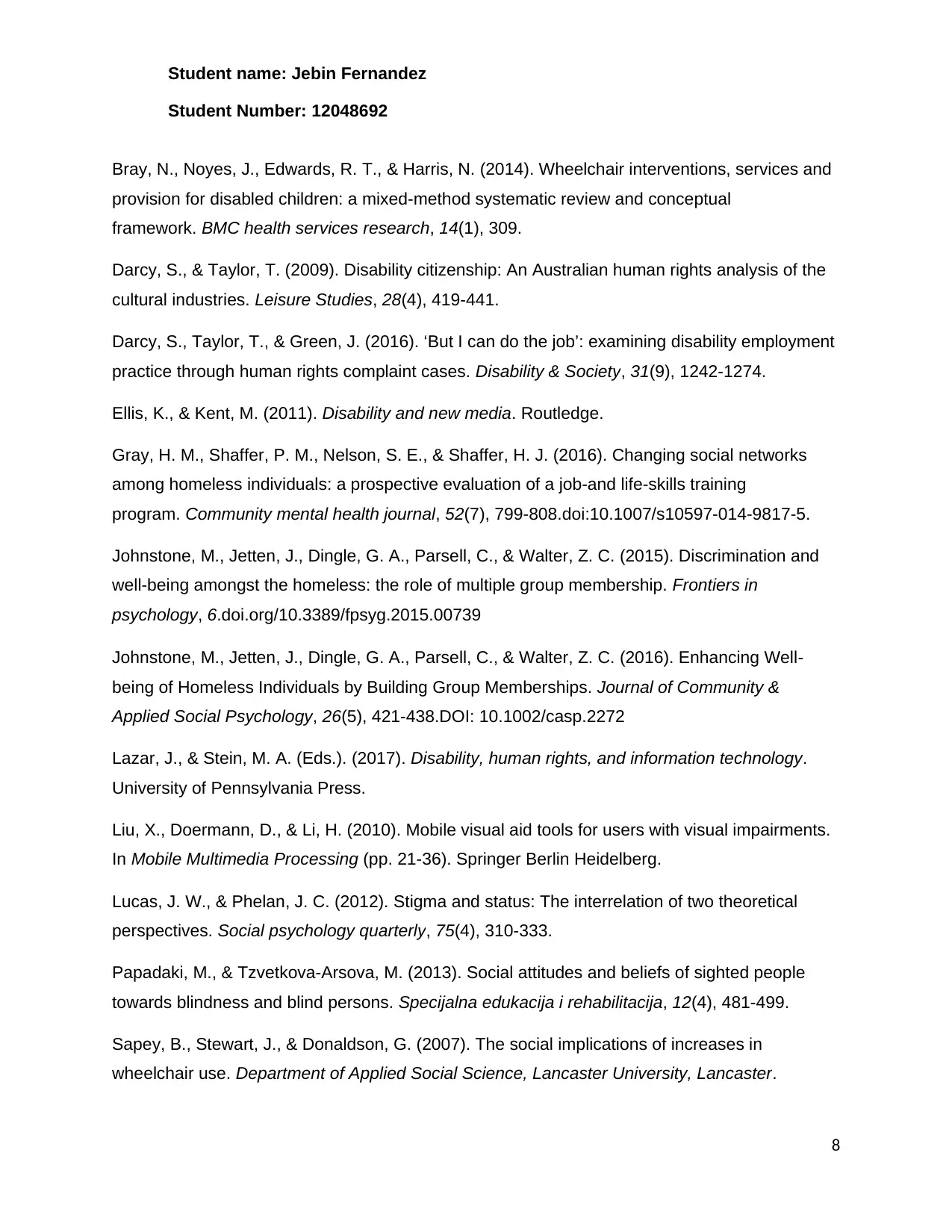
Student name: Jebin Fernandez
Student Number: 12048692
Bray, N., Noyes, J., Edwards, R. T., & Harris, N. (2014). Wheelchair interventions, services and
provision for disabled children: a mixed-method systematic review and conceptual
framework. BMC health services research, 14(1), 309.
Darcy, S., & Taylor, T. (2009). Disability citizenship: An Australian human rights analysis of the
cultural industries. Leisure Studies, 28(4), 419-441.
Darcy, S., Taylor, T., & Green, J. (2016). ‘But I can do the job’: examining disability employment
practice through human rights complaint cases. Disability & Society, 31(9), 1242-1274.
Ellis, K., & Kent, M. (2011). Disability and new media. Routledge.
Gray, H. M., Shaffer, P. M., Nelson, S. E., & Shaffer, H. J. (2016). Changing social networks
among homeless individuals: a prospective evaluation of a job-and life-skills training
program. Community mental health journal, 52(7), 799-808.doi:10.1007/s10597-014-9817-5.
Johnstone, M., Jetten, J., Dingle, G. A., Parsell, C., & Walter, Z. C. (2015). Discrimination and
well-being amongst the homeless: the role of multiple group membership. Frontiers in
psychology, 6.doi.org/10.3389/fpsyg.2015.00739
Johnstone, M., Jetten, J., Dingle, G. A., Parsell, C., & Walter, Z. C. (2016). Enhancing Well‐
being of Homeless Individuals by Building Group Memberships. Journal of Community &
Applied Social Psychology, 26(5), 421-438.DOI: 10.1002/casp.2272
Lazar, J., & Stein, M. A. (Eds.). (2017). Disability, human rights, and information technology.
University of Pennsylvania Press.
Liu, X., Doermann, D., & Li, H. (2010). Mobile visual aid tools for users with visual impairments.
In Mobile Multimedia Processing (pp. 21-36). Springer Berlin Heidelberg.
Lucas, J. W., & Phelan, J. C. (2012). Stigma and status: The interrelation of two theoretical
perspectives. Social psychology quarterly, 75(4), 310-333.
Papadaki, M., & Tzvetkova-Arsova, M. (2013). Social attitudes and beliefs of sighted people
towards blindness and blind persons. Specijalna edukacija i rehabilitacija, 12(4), 481-499.
Sapey, B., Stewart, J., & Donaldson, G. (2007). The social implications of increases in
wheelchair use. Department of Applied Social Science, Lancaster University, Lancaster.
8
Student Number: 12048692
Bray, N., Noyes, J., Edwards, R. T., & Harris, N. (2014). Wheelchair interventions, services and
provision for disabled children: a mixed-method systematic review and conceptual
framework. BMC health services research, 14(1), 309.
Darcy, S., & Taylor, T. (2009). Disability citizenship: An Australian human rights analysis of the
cultural industries. Leisure Studies, 28(4), 419-441.
Darcy, S., Taylor, T., & Green, J. (2016). ‘But I can do the job’: examining disability employment
practice through human rights complaint cases. Disability & Society, 31(9), 1242-1274.
Ellis, K., & Kent, M. (2011). Disability and new media. Routledge.
Gray, H. M., Shaffer, P. M., Nelson, S. E., & Shaffer, H. J. (2016). Changing social networks
among homeless individuals: a prospective evaluation of a job-and life-skills training
program. Community mental health journal, 52(7), 799-808.doi:10.1007/s10597-014-9817-5.
Johnstone, M., Jetten, J., Dingle, G. A., Parsell, C., & Walter, Z. C. (2015). Discrimination and
well-being amongst the homeless: the role of multiple group membership. Frontiers in
psychology, 6.doi.org/10.3389/fpsyg.2015.00739
Johnstone, M., Jetten, J., Dingle, G. A., Parsell, C., & Walter, Z. C. (2016). Enhancing Well‐
being of Homeless Individuals by Building Group Memberships. Journal of Community &
Applied Social Psychology, 26(5), 421-438.DOI: 10.1002/casp.2272
Lazar, J., & Stein, M. A. (Eds.). (2017). Disability, human rights, and information technology.
University of Pennsylvania Press.
Liu, X., Doermann, D., & Li, H. (2010). Mobile visual aid tools for users with visual impairments.
In Mobile Multimedia Processing (pp. 21-36). Springer Berlin Heidelberg.
Lucas, J. W., & Phelan, J. C. (2012). Stigma and status: The interrelation of two theoretical
perspectives. Social psychology quarterly, 75(4), 310-333.
Papadaki, M., & Tzvetkova-Arsova, M. (2013). Social attitudes and beliefs of sighted people
towards blindness and blind persons. Specijalna edukacija i rehabilitacija, 12(4), 481-499.
Sapey, B., Stewart, J., & Donaldson, G. (2007). The social implications of increases in
wheelchair use. Department of Applied Social Science, Lancaster University, Lancaster.
8
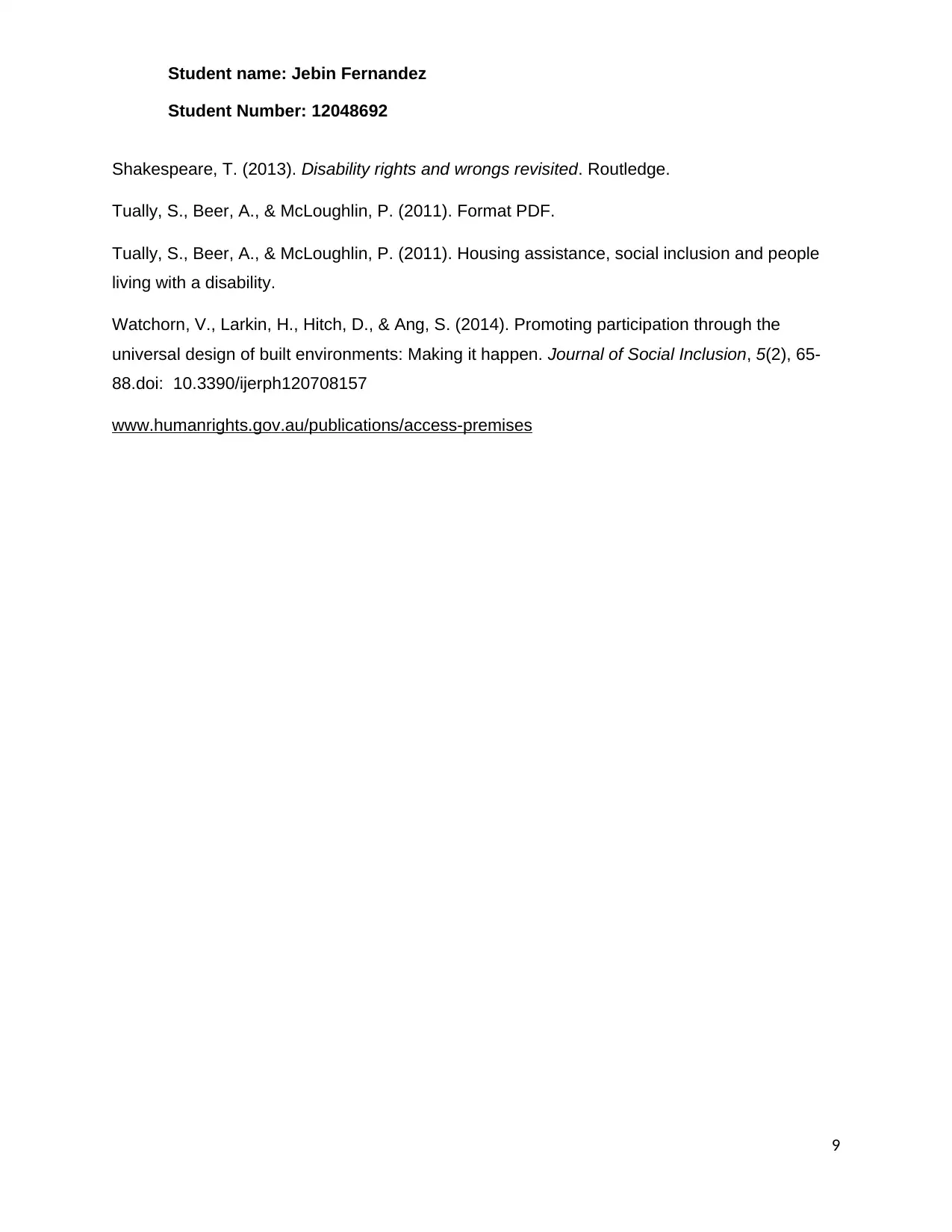
Student name: Jebin Fernandez
Student Number: 12048692
Shakespeare, T. (2013). Disability rights and wrongs revisited. Routledge.
Tually, S., Beer, A., & McLoughlin, P. (2011). Format PDF.
Tually, S., Beer, A., & McLoughlin, P. (2011). Housing assistance, social inclusion and people
living with a disability.
Watchorn, V., Larkin, H., Hitch, D., & Ang, S. (2014). Promoting participation through the
universal design of built environments: Making it happen. Journal of Social Inclusion, 5(2), 65-
88.doi: 10.3390/ijerph120708157
www.humanrights.gov.au/publications/access-premises
9
Student Number: 12048692
Shakespeare, T. (2013). Disability rights and wrongs revisited. Routledge.
Tually, S., Beer, A., & McLoughlin, P. (2011). Format PDF.
Tually, S., Beer, A., & McLoughlin, P. (2011). Housing assistance, social inclusion and people
living with a disability.
Watchorn, V., Larkin, H., Hitch, D., & Ang, S. (2014). Promoting participation through the
universal design of built environments: Making it happen. Journal of Social Inclusion, 5(2), 65-
88.doi: 10.3390/ijerph120708157
www.humanrights.gov.au/publications/access-premises
9
⊘ This is a preview!⊘
Do you want full access?
Subscribe today to unlock all pages.

Trusted by 1+ million students worldwide
1 out of 9
Related Documents
Your All-in-One AI-Powered Toolkit for Academic Success.
+13062052269
info@desklib.com
Available 24*7 on WhatsApp / Email
![[object Object]](/_next/static/media/star-bottom.7253800d.svg)
Unlock your academic potential
Copyright © 2020–2025 A2Z Services. All Rights Reserved. Developed and managed by ZUCOL.



